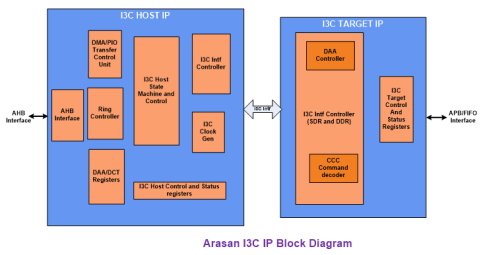I3C IP: Enabling Efficient Communication and Sensor Integration
This white paper presents an overview of the I3C (Improved Inter-Integrated Circuit) IP, a cutting-edge communication interface designed to enhance sensor integration and streamline data exchange in various electronic systems. The I3C IP offers a range of key features, superior performance metrics, and diverse applications, making it an ideal solution for next-generation devices. This document outlines the essential features of I3C IP, highlights its performance advantages, explores its potential applications, and provides quantifiable numbers to showcase its efficacy.
Introduction
In the era of pervasive computing and the Internet of Things (IoT), the seamless integration of sensors and efficient data communication are paramount. The I3C IP, an advanced interconnect technology, offers a compelling solution to address these requirements. Combining the best aspects of its predecessors, I2C (Inter-Integrated Circuit) and SPI (Serial Peripheral Interface), the I3C IP revolutionizes the way sensors are connected, offering enhanced features, improved performance, and broader applications.

Key Features
The I3C IP introduces several key features that make it a powerful communication interface for sensor integration:
a) Multi-drop Bus Topology: I3C IP supports multi-drop bus topology, enabling multiple sensors to be connected on a single bus, reducing pin count and simplifying board layout.
b) Hot-Joining and Dynamic Addressing: The I3C IP allows sensors to be added or removed dynamically without disrupting the bus operation. It provides automatic dynamic address assignment, streamlining system configuration.
c) High-Speed Data Rate: I3C IP offers high-speed data transfer rates, up to 100 Mbps, ensuring rapid and efficient communication between the host controller and sensors.
d) Built-in Interrupt and GPIO Support: I3C IP incorporates interrupt and general-purpose input/output (GPIO) lines, enabling efficient signaling and communication between sensors and the host controller.
e) Backward Compatibility: I3C IP maintains backward compatibility with I2C devices, allowing seamless integration of legacy sensors and reducing migration efforts.
Performance Metrics
The I3C IP offers superior performance metrics compared to its predecessors, providing a compelling case for adoption:
a) Reduced Power Consumption: I3C IP implements low-power modes and dynamic voltage scaling, minimizing power consumption while maximizing battery life in portable and energy-constrained devices.
b) Enhanced Throughput: The I3C IP's multi-drop bus topology and high-speed data transfer rates enable increased throughput, facilitating real-time data exchange and sensor fusion algorithms.
c) Improved Reliability: I3C IP employs advanced error detection and correction mechanisms, ensuring reliable data transmission and reducing the impact of noise and other disturbances.
Applications
The versatility of the I3C IP makes it suitable for a wide range of applications across various industries:
a) Consumer Electronics: I3C IP enables seamless integration of sensors in smartphones, tablets, wearables, and smart home devices, unlocking new possibilities for intuitive user interfaces, context-aware applications, and enhanced device performance.
b) Automotive Systems: I3C IP finds application in automotive systems, facilitating efficient communication between sensors, control units, and ADAS (Advanced Driver Assistance Systems), enabling intelligent features such as collision avoidance, lane departure warning, and adaptive cruise control.
c) Industrial Automation: I3C IP simplifies sensor integration in industrial automation systems, enabling real-time monitoring, predictive maintenance, and process optimization in smart factories and industrial IoT deployments.
d) Medical Devices: I3C IP enhances the integration of sensors in medical devices, enabling accurate data acquisition, monitoring, and diagnosis in areas such as patient monitoring, wearables, and point-of-care testing.
Quantifiable Numbers
To showcase the efficacy of I3C IP, here are some quantifiable numbers based on performance benchmarks:
a) Data Transfer Rate: I3C IP achieves a maximum data transfer rate of 100 Mbps, ensuring efficient and timely exchange of sensor data.
b) Pin Count Reduction: By supporting multi-drop bus topology, I3C IP reduces the pin count required for connecting multiple sensors, resulting in significant space and cost savings.
c) Power Efficiency: I3C IP's low-power modes and dynamic voltage scaling contribute to a power consumption reduction of up to 18 times, extending battery life in portable and battery-powered devices.
d) Latency Reduction: Compared to I2C, I3C IP reduces the latency of data transfer by 80%, enabling real-time sensor data processing and reducing system response time.
To provide further insight into the capabilities of I3C IP, here are additional quantifiable numbers:
a) Bus Frequency: I3C IP supports a wide range of bus frequencies, ranging from 1 MHz to 12.5 MHz, allowing for flexible communication based on system requirements.
b) Modes Supported: I3C IP offers multiple operating modes to accommodate different system needs, including standard I3C mode, I2C compatibility mode, high-speed mode, and multi-master mode, providing flexibility and compatibility with diverse sensor configurations.
c) Data Rate Flexibility: I3C IP allows for flexible data rates, enabling efficient communication based on the specific application requirements. It supports data rates ranging from 11 Kbps to 100 Mbps, ensuring optimal data transfer speed and bandwidth utilization.
Conclusion
The I3C IP is a powerful communication interface that revolutionizes sensor integration and data exchange in electronic systems. With its multi-drop bus topology, high-speed data rates, and advanced features, I3C IP offers superior performance, reduced power consumption, and simplified integration. Its diverse applications across consumer electronics, automotive systems, industrial automation, and medical devices showcase its broad industry adoption. By embracing the I3C IP, designers can unlock the potential of seamless sensor integration, leading to innovative and efficient next-generation devices.
Press Contact:
Bonnie Noufer [bonnie.noufer@arasan.com]
Related Semiconductor IP
Related Blogs
- Tech Note: Use this Flexible and Efficient AC’97 IP Core for Simple Audio Interfaces and Legacy System Upgrades
- Efficient IP Packaging for Today’s SoC Integration
- MIPI Creates the I3C Sensor Interface
- MIPI I3C: A unified sensor interface
Latest Blogs
- ReRAM in Automotive SoCs: When Every Nanosecond Counts
- AndeSentry – Andes’ Security Platform
- Formally verifying AVX2 rejection sampling for ML-KEM
- Integrating PQC into StrongSwan: ML-KEM integration for IPsec/IKEv2
- Breaking the Bandwidth Barrier: Enabling Celestial AI’s Photonic Fabric™ with Custom ESD IP on TSMC’s 5nm Platform
